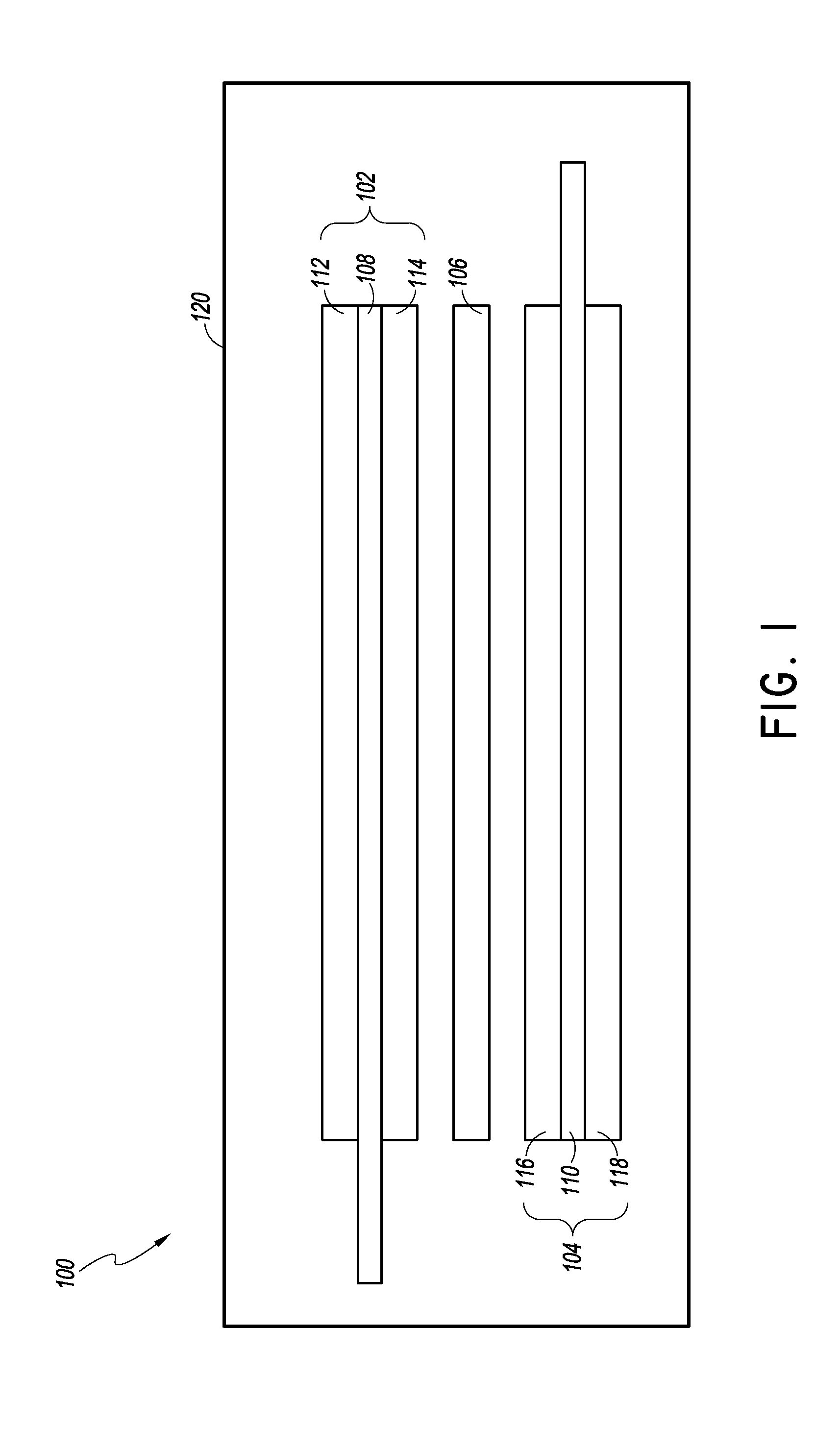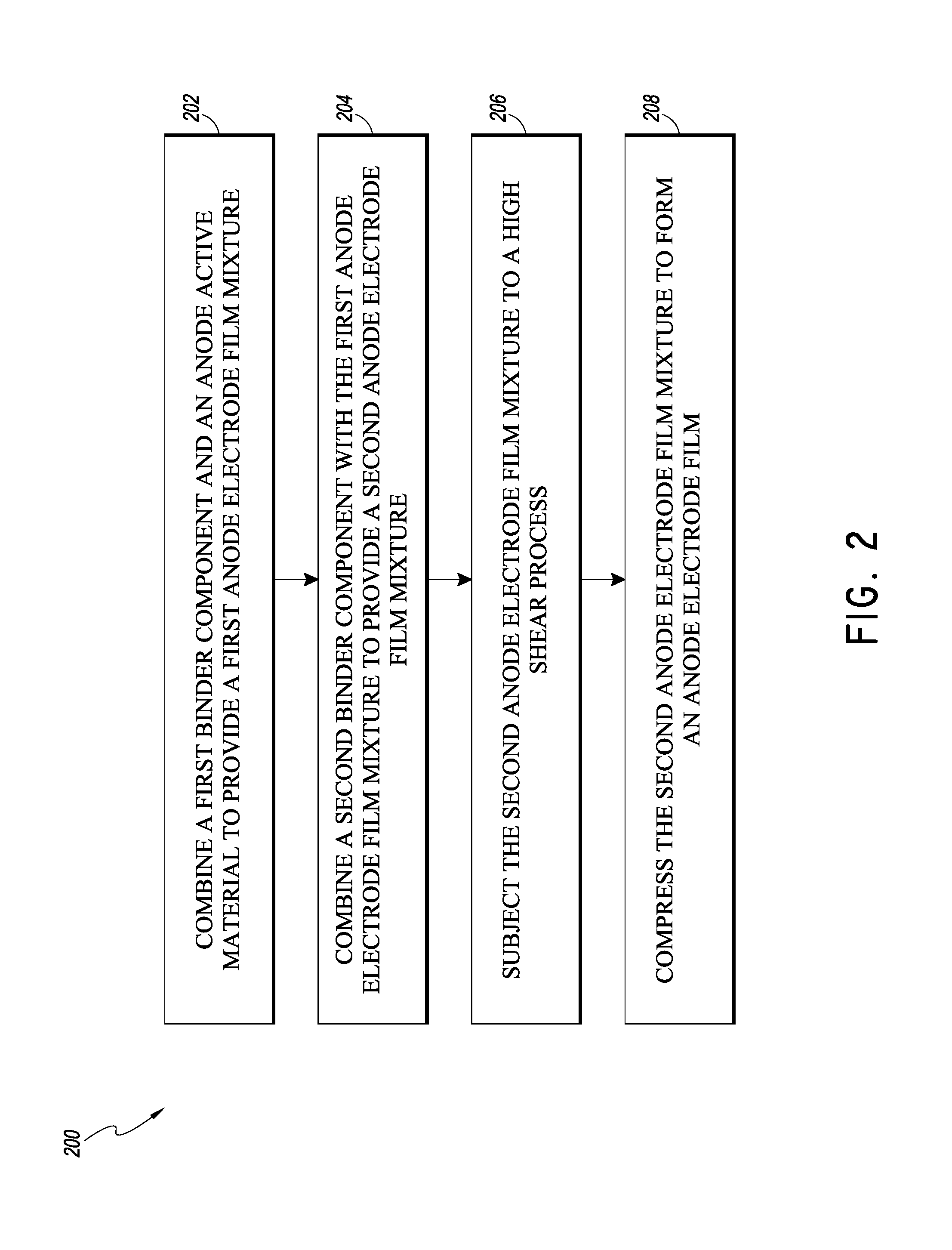Dry energy storage device electrode and methods of making the same
a technology of energy storage device and electrode, which is applied in the direction of cell components, electrochemical generators, grain treatment, etc., can solve the problems of increasing irreversible capacity loss and undesired device performance of the electrode made of ptfe binder
- Summary
- Abstract
- Description
- Claims
- Application Information
AI Technical Summary
Benefits of technology
Problems solved by technology
Method used
Image
Examples
example 1
[0119]FIG. 4 shows specific capacity performances of three lithium ion battery half-cells during a first cycle lithiation and delithiation. Each half-cell included an anode comprising a binder composition as shown in FIG. 4. The performance is shown as a function of the electrode voltage, expressed in Volts (V) on the y-axis, versus the graphite specific capacity of the corresponding anode during charge and discharge of each cell, expressed in milliampere-hour per gram (mAh / g), is shown on the x-axis. The first set of three curves sloping upwards to the right indicates the delithiation process, or discharge, of each cell. The second set of three curves sloping downwards to the right indicates the lithiation process, or charging of each cell. As shown in the figure, the anodes corresponding to the delithiation and lithiation curves of FIG. 4 include electrode films having binder which consists essentially of PTFE, PVDF or PE, respectively. The first cycle lithiation capacity for each...
example 2
[0123]FIG. 6 shows half-cell specific capacity performance of a lithium ion battery anode during a first cycle lithiation and delithiation of the anode, according to another embodiment. Electrode voltage, expressed in Volts (V) is shown on the y-axis, and the graphite specific capacity of the corresponding anode during the initial charge and discharge of the anode, expressed in milliampere-hour per gram (mAh / g), is shown on the x-axis. The delithiation and lithiation curves of FIG. 6 correspond to a half-cell having an anode which includes a composite binder consisting essentially of PVDF and PE at a mass ratio of about 1:1. The anode was fabricated using about 90 weight % graphite, about 2 weight % conductive carbon, and about 8 weight % of the binder. The anode and half-cell corresponding to FIG. 6 were prepared using similar methods as those described above in Example 1 for the anode comprising the polyolefin-binder.
[0124]As shown in the first lithiation and delithiation cycle ca...
example 3
[0125]FIGS. 7A through 7C show specific capacity performances during first lithiation and delithiation cycles of electrochemical half-cells including anodes made with binder consisting essentially of a PTFE binder, or a PTFE composite binder material consisting essentially of PTFE and the other material listed. As shown in these figures, half-cells including anodes each comprising one of three different PTFE composite binder materials are provided. The specific capacity performances during the first lithiation and delithiation cycles are shown in FIGS. 7A and 7B, respectively. The electrode voltage, expressed in Volts (V), is shown on the y-axis, and the graphite specific capacity during the initial charge and discharge of each cell, expressed in milliampere-hour per gram (mAh / g), is shown on the x-axis. In FIG. 7A, a set of curves sloping downwards to the right indicates the lithiation process, or charging of each cell, and in FIG. 7B, a set of curves sloping upwards to the right i...
PUM
| Property | Measurement | Unit |
|---|---|---|
| weight % | aaaaa | aaaaa |
| weight % | aaaaa | aaaaa |
| temperature | aaaaa | aaaaa |
Abstract
Description
Claims
Application Information
 Login to View More
Login to View More - R&D
- Intellectual Property
- Life Sciences
- Materials
- Tech Scout
- Unparalleled Data Quality
- Higher Quality Content
- 60% Fewer Hallucinations
Browse by: Latest US Patents, China's latest patents, Technical Efficacy Thesaurus, Application Domain, Technology Topic, Popular Technical Reports.
© 2025 PatSnap. All rights reserved.Legal|Privacy policy|Modern Slavery Act Transparency Statement|Sitemap|About US| Contact US: help@patsnap.com



